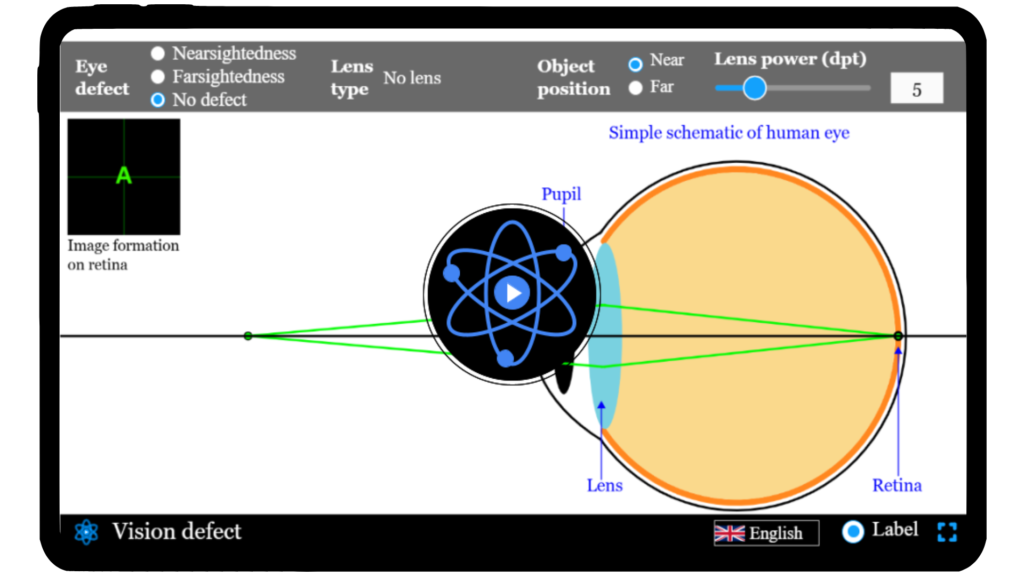Vision defect simulator
Explore vision defects like myopia and hypermetropia and experiment with lenses to restore eyesight using our interactive simulator.
Eye defects: Simulator on Myopia and Hypermetropia
I hope you folks are able to read this blog without the aid of any reading glasses. In the off-chance that you guys have trouble reading this with naked eyes, then there’s high chance that you might be having a vision defect. In this blog we are going to discuss in depth about two most common vision defects: Myopia (aka Nearsightedness) & Hypermetropia (aka Farsightedness). With the help of our simulator we will illustrate how these vison defects affect image formation on retina (aka screen of eyes). Our simulator will also help you to understand what kind of lenses and of what power are needed to rectify the vision defects. So why wait anymore, get started. Get simulating!
\( P = \frac{1}{f}\)
Mathematical description
The power of a lens is the inverse of its focal length.
where:
- \( P \) is the power of the lens in diopters
- \( f \) is the focal length of lens in m
Tutorial video
Take a quick spin through our simulator!
FAQs on Myopia & Hypermetropia
Qus 1. What is myopia (nearsightedness)?
Myopia, or nearsightedness, is a common vision condition where close objects appear clear, but distant objects are blurry. It occurs when the eyeball is too long or the cornea is too curved, causing light to focus in front of the retina.
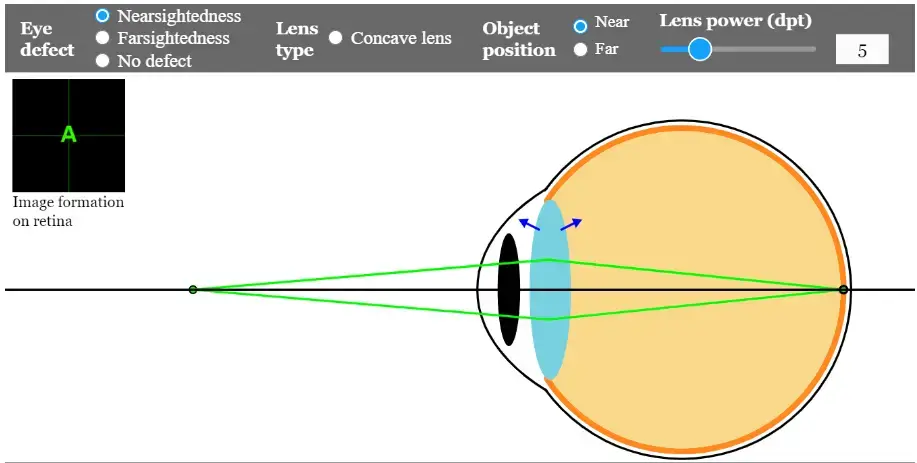
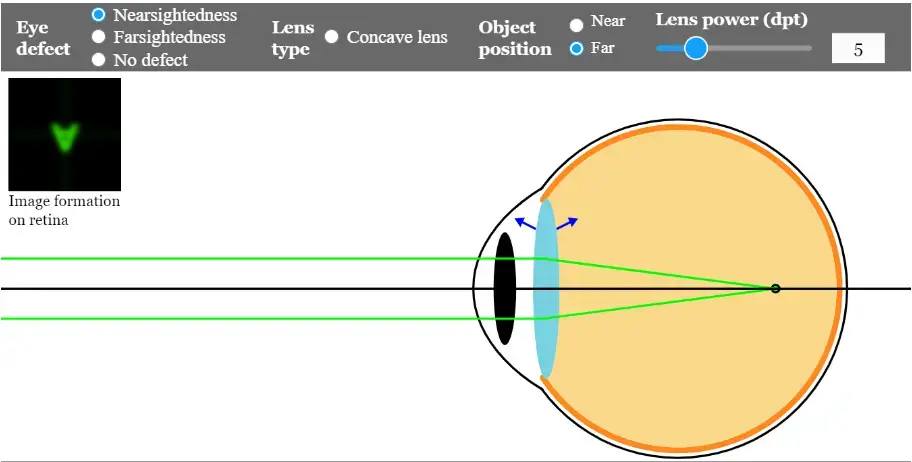
Qus 2. What is hypermetropia (farsightedness)?
Hypermetropia(aka hyperopia, farsightedness), is a vision condition where distant objects are seen more clearly than close ones. It happens when the eyeball is too short or the cornea is not curved enough, making light focus behind the retina.


Qus 3. How are people with hypermetropia (farsightedness) able to view faraway objects clearly?
In hypermetropia, parallel rays from distant objects focus behind the retina instead of on it. However, due to the eye’s ability to accommodate, people with hypermetropia can still see faraway objects more clearly. The lens in the eye adjusts by flattening slightly when viewing distant objects, compensating for the tendency to focus light behind the retina.
Qus 4. What is the difference between myopia and hypermetropia?
Myopia, or nearsightedness, causes distant objects to appear blurry, while hypermetropia, or farsightedness, makes close objects difficult to see. In Myopia, eye lens focuses light in front of the retina, whereas in hypermetropia, eye lens focuses light behind the retina.
Qus 5. What kind of corrective lenses are used for treating myopia?
For vision correction, we need to make sure that light rays are focused on the retina (which is the screen of eye). From retina optical nerves pass on the information about the image to our brain.
In myopia, light rays are focused before the retina of the eye. It can be said that the focal length of eye lens has reduced (focal power has increased). So to correct the vision we need to bring in a corrective lens which along with the eye lens will increase the focal length (decrease the focal power) and help focus light rays on retina. Hence we have to use a concave lens as a corrective lens.

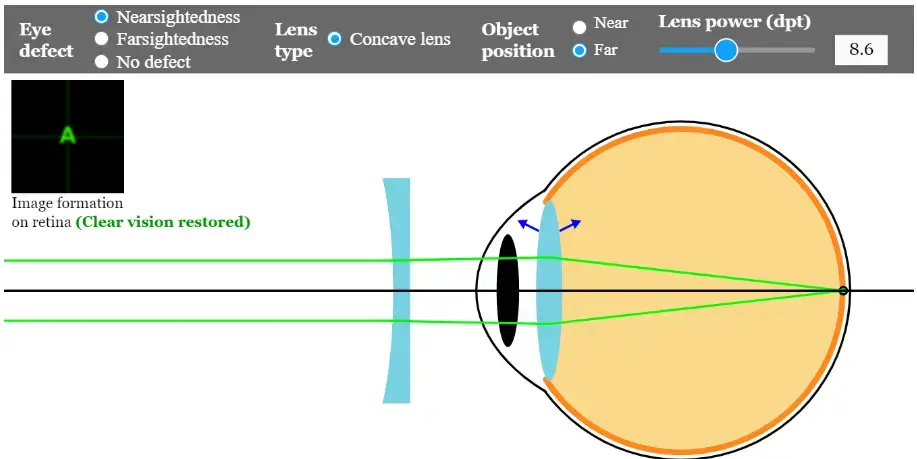
Qus 6. What kind of corrective lenses are used for treating hypermetropia?
In hypermetropia, light rays are focused beyond the retina of the eye. It can be said that the focal length of eye lens has increased (focal power has decreased). So to correct the vision we need to bring in a corrective lens which along with the eye lens will decrease the focal length (increase the focal power) and help focus light rays on retina. Hence we have to use a convex lens as a corrective lens.

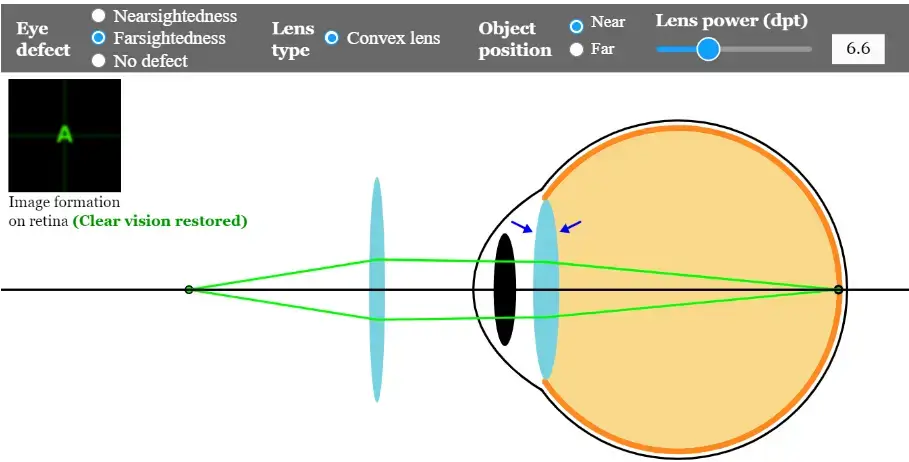
Qus 7. What causes myopia?
Myopia can be caused by genetic factors, excessive near work like reading or screen time, and environmental factors. It often begins in childhood and can progress until the eye stops growing in early adulthood.
Qus 8. What causes hypermetropia?
Hypermetropia (farsightedness) is caused by a shorter-than-normal eyeball, a flat cornea or lens, or genetic factors, leading light to focus behind the retina. It can also be influenced by age-related changes in the lens’s flexibility, making it harder to focus on near objects.
Qus 9. How does age affect myopia and hypermetropia?
Myopia often stabilizes in early adulthood, usually in the late teens or early twenties, as the eye stops growing. However, some adults may experience a slow progression of myopia throughout their lives.
As people age, the effects of hypermetropia become more pronounced. Additionally, a condition called presbyopia develops with age, which has similar effects to hypermetropia. Presbyopia occurs because the lens of the eye becomes less flexible, impairing its ability to focus light accurately and thereby exacerbating hypermetropia.
Qus 10. What are the difference between hypermetropia and presbyopia?
Presbyopia and hypermetropia are both conditions that affect near vision but differ in their causes:
Presbyopia is an age-related condition where the eye’s lens loses flexibility, making it difficult to focus on close objects. It typically starts around age 40 and affects everyone over time.
Hypermetropia (farsightedness) is usually caused by a shorter eyeball or a flatter cornea or lens, leading to light focusing behind the retina. It can be present at any age and affects the ability to see both near and far objects clearly, with near vision being more challenging.
While both conditions impact near vision, presbyopia is due to aging, whereas hypermetropia is a refractive error related to the eye’s shape.
Qus 11. What are the latest treatments for myopia and hypermetropia?
The latest treatments for myopia and hypermetropia include advanced contact lens designs, innovative eyeglass lenses, and cutting-edge refractive surgeries like SMILE and customized LASIK. Ongoing research continues to improve vision correction options.
